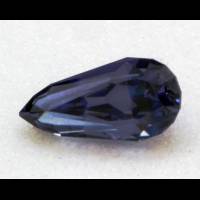Benitoite

USA
2.63 carats
© Palagems
A very rare gem with beautiful colour, high birefringence and dispersion, tough, does not have heat sensitivity, exhibits strong blue fluorescence under SW UV. Gem-quality crystals are usually small (rarely larger than 1 carat). The largest facetted benitoite on public display is a 7.5 ct gem in the Smithsonian museum. There are other larger flawless stones in existence, all in private collections.
Benitoite Gemstones by Colour
This table shows the variety of hues this gemstone can be found in. Click on a photo for more information.
Benitoite Gemstones by Size
This table shows distribution of Benitoite gemstone sizes that are listed on this site. This can give a good indication as to the general availability of this gemstone in different sizes.
Contributed photos
Lightest:0.03 cts
Heaviest:2.63 cts
Average:0.72 cts
Total photos:28
Do you have a larger Benitoite? Why not upload a photo?
| General Information | |||||||||||
|---|---|---|---|---|---|---|---|---|---|---|---|
| Chemical Formula |
| ||||||||||
| Significant stones | |||||||||||
| |||||||||||
| Benitoite Treatments | |||||||||||
| The deep blue color observed in some benitoite may have the same iron-titanium charge-transfer origin as does the blue in sapphire. It is doubtful that any of the corundum heat treatments could be applied successfully, however, since benitoite has a much lower melting point, being a silicate of composition BaTiSi3O9. G. Rossman has found (unpublished data) that benitoite gradually loses its blue color on heating in air at 600°C for 19 h. Irradiation with cobalt 60 returned some of the color center that is unrelated to the natural color – Nassau (1984) Heat-treatment may produce pinkish orange colors - Blue Chart Gem Identification, Herve Nicolas Lazzarelli, 2010, p. 3 Only the rare colourless benitoite can be heat-treated and will change to peachy/orange colour. Blue benitoite cannot be heat-treated. - Personal communication, 2014. | |||||||||||
| Physical Properties of Benitoite | |||||||||||
| Mohs Hardness | 6 to 6.5, Blue Chart Gem Identification (2010) More from other references | ||||||||||
| Specific Gravity | 3.61 to 3.68, Blue Chart Gem Identification (2010) More from other references | ||||||||||
| Tenacity | Brittle, Gemstones of the world (2001) | ||||||||||
| Cleavage Quality | Indistinct, Gemstones of the world (2001) More from other references | ||||||||||
| Fracture | Conchoidal, Gemstones (2009) | ||||||||||
| Refractive Index | 1.757 to 1.804, Blue Chart Gem Identification (2010) More from other references | ||||||||||
| Optical Character | Uniaxial/+, Blue Chart Gem Identification (2010) More from other references | ||||||||||
| Birefringence | 0.047, Blue Chart Gem Identification (2010) DoublingMore from other references | ||||||||||
| Pleochroism | Strong dichroism: blue - colorless, Blue Chart Gem Identification (2010) More from other references | ||||||||||
| Dispersion | Fatal error: Uncaught mysqli_sql_exception: Illegal mix of collations (latin1_swedish_ci,IMPLICIT) and (utf8mb3_general_ci,COERCIBLE) for operation '=' in /var/www/gemdat/gemshow_class.php:690 Stack trace: #0 /var/www/gemdat/gemshow_class.php(690): mysqli->query() #1 /var/www/gemdat/gemshow_class.php(505): gemshow_class->showdata() #2 /var/www/gemdat/gemshow_class.php(1469): gemshow_class->showblock() #3 /var/www/gemdat/gshow.php(151): gemshow_class->do_optical() #4 {main} thrown in /var/www/gemdat/gemshow_class.php on line 690 | ||||||||||




















